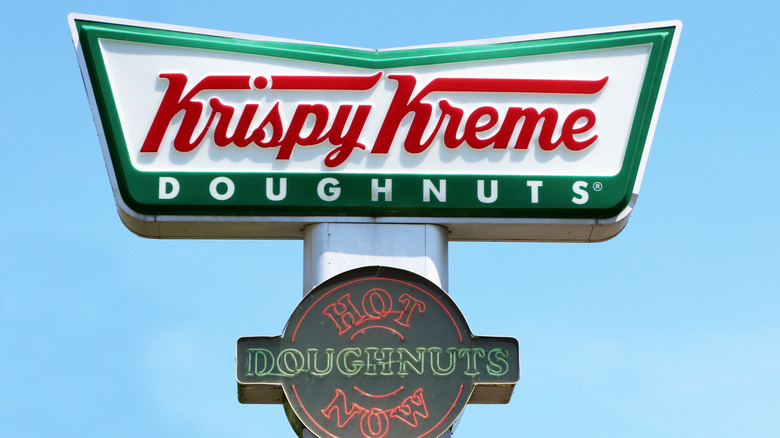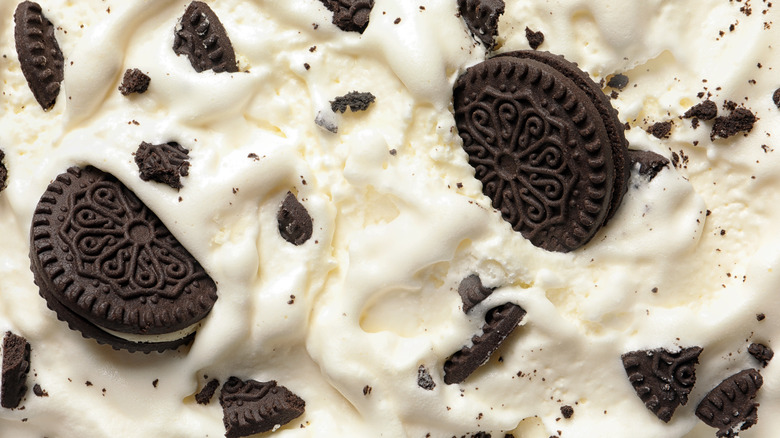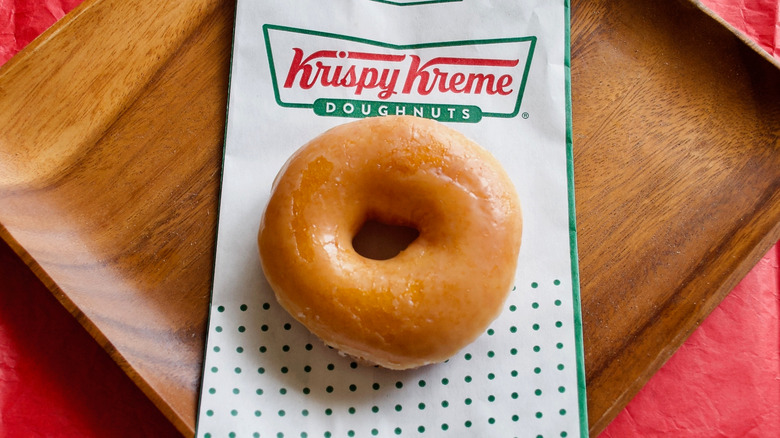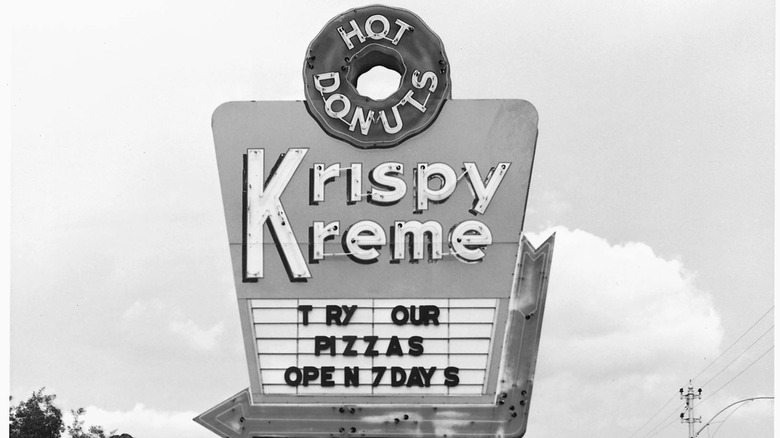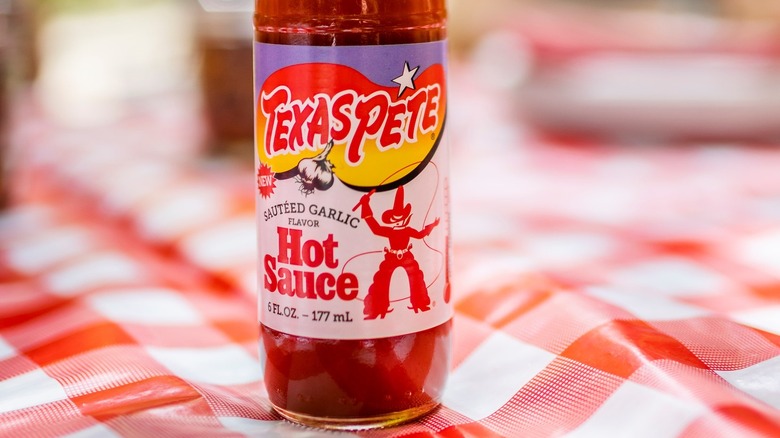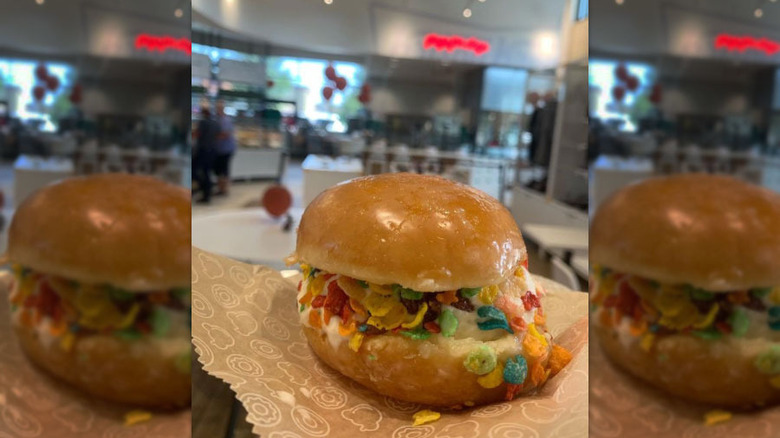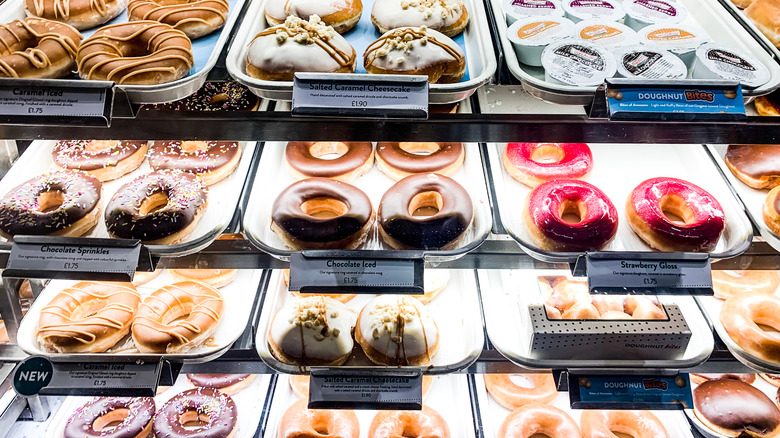The Biggest Flops In Krispy Kreme's History
Few fast food brands inspire as much devotion as Krispy Kreme. The chain's iconic Hot Now light is a beacon to doughnut lovers across the world. Store openings and promotions from the chain inspire the same kinds of lines as new iPhone releases. The brand knows what its customers want, and delivers consistently.
The secret of Krispy Kreme's success is that it sticks to the classics. While other chains like Dunkin' and Tim Hortons attempt to cast a wide net by offering savory breakfast and lunch food, Krispy Kreme relies on its original glazed doughnut to get customers in the door. Krispy Kreme knows its assignment, and its reluctance to experiment leaves it less open to dramatic flops than some other fast food places.
Despite Krispy Kreme's solid record of delivering quality products, no brand lasts over 80 years without releasing a couple of flops. On the few occasions when Krispy Kreme has ventured beyond its doughnut and coffee lane, it has missed the mark. The company has also made some highly-publicized efforts to expand into new regions that weren't ready to handle the Krispy Kreme experience. From poorly thought out pastries to failed attempts at growth, these are the worst Krispy Kreme flops of all time.
The Kool Kreme ice cream attempt melted away fast
Krispy Kreme has tried to make ice cream work a few times but the attempt has never panned out in the long run. They're known as a place to get sweet treats in the morning, and a representative told QSR in 2008 that the chain hoped ice cream would boost sales during the afternoon when fewer people buy doughnuts. The 2009 ice cream launch was branded Kool Kreme, and included soft-serve, doughnut sundaes, milkshakes, and a Blizzard-like blended concoction called an Arctic Avalanche. (Krispy Kreme tried shakes again a few years later, this time with the addition of a mini doughnut — because more sugar!)
Since ice cream doesn't require cooking, you might think it would be an easy add-on to Krispy Kreme's existing menu. However, as McDonald's ice cream machine struggles show, frozen treats can cause big headaches for restaurant operators. Early results from the Kool Kreme tests markets appeared positive, but the product line didn't stick around, and the company doesn't mention ice cream anywhere on its current website.
Whole wheat doughnuts failed at being healthy
Doughnuts aren't anyone's number one choice for a healthy breakfast. They're rings of deep-fried cake, and there's only so much you can do to reduce their caloric load. Krispy Kreme doughnuts are actually lighter than their direct competitors, with the original glazed registering 70 fewer calories than equivalent products from Dunkin' and Tim Hortons. Of course, all those calories come in the form of refined carbs, oils, and sugar, so calling Krispy Kreme health food is a big stretch.
That didn't stop Krispy Kreme senior VP of marketing Stan Parker from telling QSR Magazine in 2007 the chain's new whole-wheat doughnut was "an alternative for health-conscious consumers with the benefits of 100 percent whole-wheat." Despite Parker's optimism, Krispy Kreme wasn't able to convince suspicious customers that the whole wheat doughnut was a healthier choice.
Dietitian Doug Cook wrote in the Toronto Star that the whole wheat doughnut's hefty doses of trans fat and sugar canceled out any potential nutritional value. Even worse, the whole wheat doughnut barely had fewer calories than an original glazed. The company phased out its one gesture at healthfulness and has since embraced its identity as a supplier of decadent indulgences.
Krispy Kreme challenged Dunkin' in New England and lost
New England is synonymous with clam chowder, lobster rolls, and Dunkin'. A survey reported in the Seattle Times found that around half of Bostonians went to Dunkin' at least once a month. Local celebrities wear their Dunkin' addictions with pride, with Ben Affleck and Charli d'Amelio proclaiming their love for the chain.
Nobody can accuse Krispy Kreme of cowardice, because the chain has tried to take on Dunkin' on its home turf two times, and is considering trying again. The first attempt came during the company's ill-fated period of rapid expansion during the early 2000s. Boston.com recorded that the chain opened seven out of a promised 16 stores, but none of the branches survived into the 2010s.
Patch.com says that Krispy Kreme unveiled more stores in the Boston area in 2016, but only managed to open two of the four it announced before both closed. Undeterred, the company mentioned in their initial public offering statement in 2021 that they were considering giving Boston another chance. Perhaps the brand would be better off ceding the Northeast U.S. to Dunkin'. Philadelphia has proved just as hostile as Boston to Krispy Kreme, with all three Philly Krispy Kremes dying after a few years according to BillyPenn.
Krispy Kreme pizza didn't stick around
Krispy Kreme pizza resides in the same realm of pop culture as Bigfoot, the Jackelope, and the Loch Ness Monster. It's hard to find any evidence that it ever existed aside from one mysterious photo posted to Krispy Kreme's Facebook page. Intrepid sleuths in the comments section of that photo say that the cars in the parking lot appear to be late-1950s and early-1960s models, so we can infer that the store was selling pizza sometime in the mid-60s, towards the beginning of pizza's popularity in America. The fact that this lone photo is the only surviving record of Krispy Kreme pizza suggests the savory experiment didn't last long. Was the pizza made with doughnut batter? Was it the product of a rogue franchisee? We may never know.
If Krispy Kreme actually tried and failed at expanding into pizza, it's in good company. Even fast-food titan McDonald's struggled to make pizza work, devoting years of labor and millions of dollars toward developing McPizzas in the '80s, only to remove the item from most stores' menus by the end of the '90s. Pizza, with its long cook times and specialized techniques, is an awkward fit for places like McDonald's or Krispy Kreme that rely on speed and efficiency.
Texas Pete hot sauce doughnuts flopped with testers and never made it to stores
Krispy Kreme is proud of its hometown of Winston-Salem, North Carolina. That local pride has manifested in two successful crossovers with North Carolina soda brand Cheerwine. As Money reports, the success of the company's Cheerwine Kreme-filled doughnut inspired Krispy Kreme to seek out more Winston-Salem-based collaborations. They turned to Texas Pete hot sauce, which despite its name has always been made in North Carolina.
A hot sauce creme-flavored doughnut made it to the testing phase of development but never escaped the lab to make its way into the public's hands. An email from a Krispy Kreme employee explained "The consensus was that it might be a little polarizing."
If Krispy Kreme had been a little bolder and released their creation, they might have had a hit on their hands. In 2018, a vendor at the North Carolina State Fair earned a legion of fans with Texas Pete-glazed mini doughnuts. A reviewer at WRAL found that the doughnut had the "heat I expected and was well-balanced with the glaze's sweetness."
Scoop sandwiches proved you can have too much of a good thing
Apparently not learning their lesson from Kool Kreme, Krispy Kreme once again tried to introduce a line of frozen desserts in 2018. Thrillist wrote that this time, ice cream was going to be just one component of a new, refreshed store design that included digital menu boards and a doughnut customization bar. The star of the new menu launch was the scoop sandwich, an ice cream sandwich with doughnuts as the buns. The menu revamp arrived in July of that year at a Krispy Kreme in Concord, North Carolina. The brand announced in a press release that it was planning to open 45 locations with the new menu items by 2020.
Despite all the hype surrounding the scoop sandwich when it debuted, there's no evidence it was ever available outside of a few test locations, and it's not on the current Krispy Kreme menu. Ruth Suehle at Geek Mom reviewed a scoop sandwich she bought at the Concord store and found that it had too much sugar to be palatable. A reviewer at the UT Daily Beacon also found the sugar content overwhelming, saying that "after finishing the Scoop Sandwich, I felt like I would barf if I took another bite."
Krispy Kreme's Hong Kong exit saddened residents
In the early 2000s, Krispy Kreme had seven franchises in Hong Kong. At the time, according to Hong Kong Living, the chain was the only American doughnut shop in the city. The brand's abrupt and total exit from the Hong Kong market in 2008 devastated local doughnut lovers, who were left with no other options.
A writer in East West Hospitality suggests that doughnuts were too different from local Hong Kong baked goods, which tend to be less sweet than Western desserts. A Krispy Kreme doughnut also sold for around three times as much as an item from a local sweet shop.
The real reason that Krispy Kreme failed in Hong Kong may be that it didn't change its standard menu to suit the region's tastes. The chain has had success adapting to other cultures' cuisines, introducing doughnut waffles in Indonesia and matcha doughnuts in Japan. The doughnut shops that opened in Hong Kong after Krispy Kreme closed offer flavors you wouldn't find in America, like J.Co's Avocado DiCaprio.
